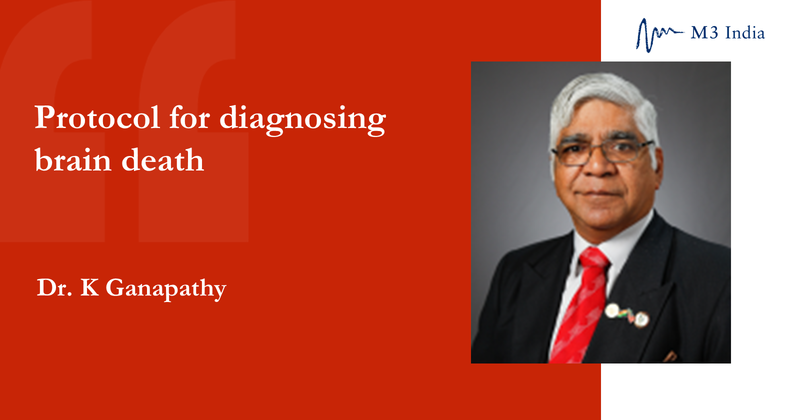Protocol for diagnosing brain death: Dr. K Ganapathy
M3 India Newsdesk Sep 20, 2018
Dr. Ganapathy Krishnan, an eminent Neurosurgeon shares his personal experience and knowledge in certifying brain death over two decades, in a quaternary care hospital.

Till six decades ago, death was considered to be a specific point in time, referring to the precise moment at which life ends. With the availability of ventilators, even determining when death has occurred, is becoming difficult, as cessation of functions, often occurs at different times, in different organ systems. With increasing accessibility to intensive care units (ICUs) even in Tier II and Tier III cities, and the government making it mandatory to notify brain death, to facilitate cadaveric organ transplants, it behoves every clinician to thoroughly understand what brain death actually means.
Review of the world literature demonstrates that there is no international consensus even in what exactly constitutes brain death. An individual could be considered legally dead in one country but not in another!
Most countries including India agree that the clinical diagnosis of brain stem death is sufficient for certification of death in adults. Clinical evaluation criteria must be strictly adhered to and limitations of so called confirmatory tests recognized.
Evolution of the concept of brain death
Before 1960, death was defined as the complete and irreversible cessation of spontaneous cardiac and respiratory functions. Brain death was first described by two French physicians, Mollart and Goulon and termed ‘coma depasse’ (a state beyond coma). Before the advent of support systems, death was assumed to have taken place, when the heart irreversibly stopped. Transplantation programs with the need for viable organs, necessitated re-evaluation of the concept of death.
Today, brain death is considered equivalent to death of the individual, and death of the brain stem is accepted as death of the brain. Prior to availability of mechanical ventilation, patients without a respiratory drive would become anoxic and die. Today patients with severe, irreversible and nearly total brain dysfunction, can be maintained on a ventilator nearly indefinitely.
Even within the brain, not all cells die at the same time. In a severe vegetative state, the cerebral cortex, the centre of cognitive functions including consciousness and intelligence, may be dead while the brain stem controlling basic life support is still functioning.
The biological death of the whole human organism cannot (and is not required to) be proven during the diagnosis of brain death. Absence of brain stem reflexes is fundamental to the clinical determination of brain death. This includes confirmation of apnoea.
Clinical evaluation of brain death
The accuracy, reliability, reproducibility, and ease in carrying out clinical tests to confirm brain stem death make clinical evaluation sufficient for establishing the diagnosis.
Neurophysiological and imaging studies are not necessary to confirm brain death. A repeat clinical evaluation 6 hours later is mandatory.
Clinicians should make it clear to the relatives, that ventilation is not being withdrawn to let the patient die, as the patient is already dead, but because continuing ventilation is indicated only for survival of individual organs.
The Evaluation Team
In India, according to the Transplantation of Human Organs Act, 1994 (Sub section 6 of Section 3), ‘brain stem death’ refers to the stage at which all functions of the brain stem have permanently and irreversibly ceased.
This is to be certified by a ‘Board of Medical Experts’ consisting of:
- The Medical Superintendent (MS)/ in charge of the hospital in which ‘brain stem’ death has occurred
- A Specialist
- A Neurologist or a Neurosurgeon nominated by the MS, from a panel approved by the Appropriate Authority, and the doctor under whose care the ‘brain- stem’ death has occurred.
Amendments in the THO Act 2011 have allowed selection of a surgeon/physician and an anaesthetist, if an approved neurosurgeon or neurologist is unavailable.
Evaluation criteria
In India, recognition and certification of brain stem death was legalized in 1994, when The Transplantation of Human Organs (TOHO) Act was passed.
Brain death however should not even be thought of, until the following reversible causes of coma have been excluded:
- Intoxication (alcohol)
- Drugs including muscle relaxants
- Primary hypothermia
- Hypovolemic shock
- Metabolic and endocrine disorders
The clinical diagnosis of brain death should be performed in three steps:
- Establishing etiology
- Excluding potentially reversible syndromes that may produce signs similar to brain death
- Demonstrating clinical signs of brain death including coma, brain stem areflexia and apnoea
Hypernatremia and diabetes insipidus is more often the effect rather than the cause of brain death.
For certifying brain death, the following need to be evaluated:
- Presence of irreversible coma
- Cessation of spontaneous respiration confirmed with apnoea tests
- Pupillary light reflexes, corneal reflexes, doll’s eye movements, gag reflex and cough reflex (tracheal) should be absent
- Eye movements on caloric testing bilaterally, motor response in any cranial nerve distribution, and motor response on stimulation of face/limb/trunk should also not be elicitable.
Disclaimer- The views and opinions expressed in this article are those of the author's and do not necessarily reflect the official policy or position of M3 India.
The writer, Dr. Ganapathy Krishnan is a Emeritus Professor of Neurosurgery and the Past President of Neurological Society of India and Indian Society for Stereotactic & Functional Neurosurgery.
-
Exclusive Write-ups & Webinars by KOLs
-
Daily Quiz by specialty
-
Paid Market Research Surveys
-
Case discussions, News & Journals' summaries